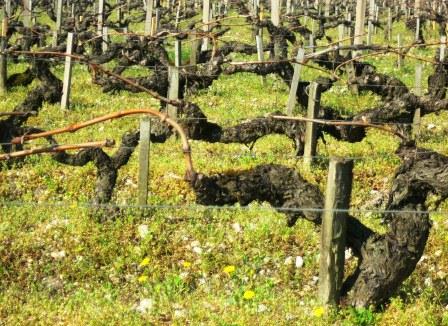
Learn everything about the Haut Medoc, Listrac, Moulis, Medoc, covering all the best wines and vineyards, with detailed profiles for all the top wines, with wine tasting notes, wine buying guides, wine and food pairing tips, and detailed histories for the top wines and wineries in the Haut Medoc appellation as well in the communes of Listrac, Moulis, and the Medoc.
If you want to read about other Bordeaux wine producers in different Bordeaux appellations: Links to all Bordeaux Wine Producer Profiles If you are interested in learning more about Bordeaux wine, we offer numerous articles on everything about Bordeaux wine, from a history of the Bordeaux region and the famous 1855 Classification, the grapes used to produce Bordeaux wine and even vintage summaries covering Bordeaux wine from 1900 to today: All About Bordeaux Wine Guide
Complete Guide to all the best chateaux, wines, vineyards and producers in the Haut Medoc:
Map of Haut-Médoc Bordeaux Chateau
- Belgrave
- Belle-Vue
- Bernadotte
- Branas Grand-Poujeaux
- Cambon Le Pelouse
- Camensac
- Cantemerle
- Charmail
- Chasse Spleen
- Cissac
- Citran
- Clarke
- Clement Pichon
- Coufran
- Fourcas Borie
- G d’Estournel
- Haut Condissas
- La Lagune
- Lanessan
- La Tour Carnet
- La Tour de By
- Les Grands Chenes
- Malescasse
- Mauvesin Barton
- Peyrabon
- Potensac
- Poujeaux
- Preuillac
- Rollan de By
- Saint Paul
- Senejac
- Sociando Mallet
Overview of the Haut Medoc: The Haut Medoc Bordeaux wine appellation is massive. In fact, the Haut Medoc appellation is the largest area under vine in the Medoc with a total of 4,198 hectares planted with vines.
Almost 400 different chateau produce wine or operate vineyards in the Haut Medoc today. Out of that number, about 250 produce and sell their own wine. The remaining 150 growers sell their wine or grapes to local cooperatives or negociants.
In an average year, 2,333,000 cases of wine are produced. Cabernet Sauvignon is the main grape in the region. Only red wines are allowed by AOC law to be produced in the Haut Medoc. The few white Bordeaux wines made in the region are sold as Bordeaux Blanc wine.
When you compare the Haut Medoc appellation with the other lesser communes, because there are so many different terroir and soils in Bordeaux, as well as diverse approaches to winemaking, there is no particular style of Bordeaux wine produced here.
It’s wide and varied. With hundreds of Chateaux, there are some that push the quality envelope as far as it can go, hoping to produce the best wines possible, while other chateaux are content to simply try selling what they make, simply because it says Bordeaux on the label. While only 5 chateaus were included in the 1855 Classification from Haut Medoc, it is home to the majority of Cru Bourgeois classed chateaux.
Haut Medoc versus the Medoc: One important fact to keep in mind is, the Haut Medoc appellation is not the same as the Medoc, which includes not only the Haut Medoc appellation but all the other important communes in the Left Bank as well, Pauillac, Margaux, St. Estephe and St. Julien.
Adding more confusion than clarity, the Medoc is both a commune and an appellation with only a few wines of repute. The Medoc appellation is located to the north and west of the St. Estephe appellation and the large area of the Left Bank we previously referenced.
The twelve main communes that make up the Medoc appellation are: Begadan, Blaignan, Couqueques, Civrac, Jau-dignac-et-Loirac, Lesparre, Ordonnac, Prignac, St. Christoly, St. Germain d’Esteuil, St. Yzans and Valeyrac.
If the confusion between the large encompassing Medoc, the Medoc appellation, and the Haut Medoc was not enough, to make things even more difficult for the moment, the Medoc is completely different from, and not to be confused with the area located to the north of St. Estephe, which was at one time known as the Bas Medoc. We will get to that in a moment.
The Medoc appellation is quite large at 5,742 hectares. To better illustrate how large an area that is, as a way of comparison, that is close to 1/3 the size of the entire Medoc. Only red wines were allowed to be produced in the Medoc. That changed in 2025. From that point forward, producers in the Medoc making white Bordeaux wine were given the choice to sell their wine as Medoc Blanc, or generic AOC Bordeaux Blanc wines.
Prior to 2020, vineyard plantings were allowed a density of 5,000 vines per hectare. In 2020, the AOC laws were changed and so producers are now planting at higher levels of vine density. The other change in the Medoc vineyards was the planting of more Merlot and less Cabernet Sauvignon in the soils where you find more clay and sand.
The addition of more Merlot certainly gives the wines more flesh and rounder textures as well as early drink ability. Another benefit to the growers adding more Merlot is that with their naturally cooler climate, it is easier for the Merlot to ripen than Cabernet Sauvignon.
Bas Medoc is a term that is seldom used these days. It ceased to exist at some point in the 1940s when the chateaux petitioned for a change claiming the term Bas Medoc placed them at a commercial disadvantage. Prior to being known as Bas Medoc, the area was called little Holland, due to the fact that those vineyards were the most heavily dredged and drained Bordeaux swamplands by the Dutch.
This took place at the same time when much of the marshland was drained in the 17th century. Prior to draining the region, the area was not fit for agriculture. Today, the wines from Bas Medoc are listed simply as Medoc on the label. Now you know why the term Medoc can be a little difficult to follow for some consumers.
The majority of the terroir in the Medoc is inferior to much of the soil that is found in the Haut Medoc. That is not to say that you cannot find a few very good in the Medoc, because you can.
And because the appellation is not prestigious, most of the best wines from the Medoc can be found at very attractive prices. The best wines from the Medoc come from vineyards located closest to the river. Back to the Haut Medoc, the subject at hand.
The taste, character, and style of wine from the Haut Medoc: For the top wines of the Haut Medoc region, the best producers are located closest to the area of the Medoc stretching to the north of Saint Estephe all the way south to below the Margaux appellation.
Because of the massive, sprawling area, differences in terroir, financial capabilities of the chateaux, and of course soils play a big part in setting the quality and style of the wines from the Haut Medoc.
Several of the best producers from Haut Medoc can make wines of classified growth quality. The wines of Haut Medoc have the ability to age and evolve and are interesting to add to blind tastings with better known 1855 classified wines.
Due to the massive size of the Haut Medoc, offering a single general description of the style and character of wines from the Haut Medoc can be difficult. Wines and the style of the wine vary widely from estate to estate. For example, Chateau La Lagune and Chateau Cantemerle produce elegant, refined, floral wines.
Chateau La Tour Carnet is modern in style and Chateau Sociando Mallet, along with Chateau Potensac are both traditional producers that make wines many feel are rustic or strict in personality. If you choose wisely, the Haut Medoc can provide very good, Cabernet Sauvignon-based wine Bordeaux wine, for fair prices.
If you are going to visit the chateaux and vineyards in the Haut Medoc, you should also read these 2 articles to help you better plan your trip: Where to Eat when visiting the Haut Medoc and Bordeaux as well as Guide to the best hotels and other places to stay in the Haut Medoc and Bordeaux
History of the Haut Medoc appellation: The birth of the Haut Medoc appellation coincides with the draining of the area by the Dutch. Much of what we know of as the Haut Medoc appellation today consisted of swamps and marshlands until the area was drained in the 17th century.
Once the Haut Medoc appellation was officially created, according to the order made November 14, 1936, to be an Haut Medoc AOC Bordeaux wine, the wine must come from any of the communes from the Haut Medoc appellation which include: Blanquefort, Le Taillan, Parempuyre, Le Pian, Ludon, Macau, Arsac, Labarde, Avensan, Castelnau, Soussans, Arcins, Moulis, Listrac, Lamarque, Cussac, Saint-Laurent de Medoc, Saint-Sauveur, Cissac, Vertheuil or Saint-Seurin de Cadourne. On this page, you will also from some of the best chateaux located in the Medoc appellation as well.
Haut Medoc wine and food pairings: The wine of the Haut Medoc appellation can be more stern and tannic than you might find in the other appellations in the Left Bank. But the wines are still just as versatile.
Haut Medoc Bordeaux makes excellent wine and food pairing with most game, beef, veal, pork, lamb, or duck dishes. Haut Medoc wines also pair well with roast chicken and a wide variety of other roasted or grilled meats, game, or seafood dishes. Haut Medoc wines can also make perfect pairings with a wide variety of hard and soft cheese. Add some grilled bread and charcuterie and you are all set!
The Top Ten Facts You Need to Know about Haut Medoc
#1 Haut Medoc is the largest appellation in the Left Bank with 4,198 hectares planted with vines.
#2 Haut Medoc is not the same as the Medoc.
#3 Haut Medoc has only 5 chateaux in the 1855 Classification.
#4 Haut Medoc was created due to the draining of the swamps in Bordeaux by the Dutch.
#5 Haut Medoc, Listrac, and Moulis vineyards combined, produce on average, at least 5% of all the wine made in Bordeaux each year.
#6 Haut Medoc is the home to one of the oldest properties in Bordeaux. Chateau La Tour Carnet. The estate, with its moat and drawbridge, dates back to the 12th century.
#7 Haut Medoc has the highest concentration of Cru Bourgeois classed estates of any Bordeaux appellation.
#8 Numerous Haut Medoc chateau classed as Cru Bourgeois are only a stone’s throw, or single vine away from the major appellations with their 1855 Classified chateaux.
#9 Chateau Cantemerle was originally left off the 1855 Classification by accident. It took almost 2 years to rectify that mistake.
#10 Haut Medoc chateaus are the first vineyards visitors see when driving on the famous D2 highway from the city in Bordeaux traveling north as well as the first when entering Bordeaux heading north to south.
The best vintages of Haut Medoc Wines are: 2023, 2022, 2021, 2020, 2019, 2018, 2017, 2016, 2015, 2014, 2012, 2010, 2009, 2006, 2005, 2000, 1996, 1995 and 1990. Older vintages could deliver good tasting experiences for some wines, but at more than 25 years of age, most are past their prime and should be purchased with extreme caution.
Generally speaking, the wines of the Haut Medoc will be strong in the same vintages as most of the northern Medoc.
Older vintages are not listed here because for most estates in the Haut Medoc, they did not have the terroir or the necessary funds to be able to produce great wine in most vintages prior to 1982 for the top chateaux, and probably 2000 for most of the properties active in the appellation.
That is not the case today as many estates are making top wine in the Haut Medoc appellation. To read about vintages from the Haut Medoc and all the other Bordeaux appellations Bordeaux Vintage Charts 1959 Through Today If you are interested in reading more detailed information on other vintages for the Haut Medoc, along with all the top Bordeaux appellations, please read: Bordeaux Year to Year Detailed Vintage Reports 1900 to Today
Grapes of the Haut Medoc The five main Bordeaux varietals for red wine are grown in the region; Cabernet Sauvignon, Merlot, Cabernet Franc, Malbec, and Petit Verdot. White Bordeaux wine is also produced in the Haut Medoc from Sauvignon Blanc and Semillon, although other grape varieties are also allowed by law. However, white Bordeaux wine produced in the Haut Medoc must be sold and labeled as generic AOC Bordeaux wine.
The terroir and soil of Haut Medoc: The soil of wines from Haut Medoc all feature deposits of Garonne gravel with varying degrees of limestone, sand, and clay. However, the best vineyards have deep gravel soils. The gravel affords natural drainage, which helps much of the flat, or slightly sloped elevations in the appellation remove excess water. The gravel also allows the vines to dig deep into the soil for nutrients.
The gravel also retains warmth and reflects sunshine to the vines. Interestingly, a few vineyards in the appellation are located quite close to the city, which in turn have some of the warmest terroirs in the Haut Medoc. Because the Haut Medoc covers so much ground, there is a wide diversity of terroir’s, micro-climates, and soils.
Broadly speaking, in the northern part of Haut Medoc appellation, you find more gravel, limestone, and clay, with cooler soils and colder temperatures. The harvest in the north is often a day or days later than what takes place in the south.
In the west of the appellation, the soils often have a higher clay content and as you travel further south, you find finer soils and flatter terroir with gravel, but with more sand and slightly warmer temperatures as well.
The elevations in the Haut Medoc naturally vary as well, ranging from 3 meters up to 44 meters, (145 feet) which is the highest altitude found in the entire Left Bank! The highest elevation in the Medoc is located in the vineyard of Chateau Fonreaud.
Those differences in terroirs and soils are why we experience such a wide display of styles in the wines. To get an idea of how the soil and terroir of the Haut Medoc compares to the other important appellations in Bordeaux; The terroir and soil of Bordeaux
There are 21 different communes that make up the Haut Medoc appellation. The two regions that stand out above the others for their terroir are the appellations of Moulis and Listrac.
Moulis, granted appellation status in 1938 is the smallest appellation in the Medoc with only 633 hectares of vines. 53 different Bordeaux chateau make wine in Moulis. On average, close to 315,000 cases of wine are produced each year in Moulis.
Moulis is packed with Cru Bourgeois classified chateaux. 14 are located in the commune, taking up slightly more than 60% of the entire 633 hectares of vines. The remainder of the growers sells their harvest to a cooperative.
Moulis is situated inland and away from the Gironde, off the D1 highway just north of Castelnau-Medoc.
That means the terroir is also slightly cooler than you find in much of the Haut Medoc. Additionally, because the vines are situated inland away from warmth of the Gironde estuary, this makes the vineyards in Moulis prone to damage from frost.
Cabernet Sauvignon and Merlot are the two key grapes planted in the appellation. The terroir of Moulis is mostly gravel with some clay and limestone in the soil.
Due to the better natural drainage, warmer temperatures, and higher concentrations of gravel in the soil, Moulis produces more elegant wine than its neighbor, Listrac.
Chateau Poujeaux, Chateau Chasse Spleen, and Chateau Branas Grand-Poujeaux are probably the three finest, most consistent producers in Moulis.
Listrac is 668 hectares in size with about 567 hectares planted with vines. While 74 growers have vineyards in the commune, only 40 chateaux are producers. The remainder of the estates sell their harvest to cooperatives. On average, close to 325,000 cases of Bordeaux wine are produced each year in Listrac. While there were vines planted in Listrac in the 12th century, in the modern era, Listrac is a late bloomer.
The area only became an appellation in 1957. The terroir is mostly gravel with clay, limestone, and sandy soil. Interestingly, Listrac has some of the highest elevations in the Medoc at a whopping 141 feet, 43 meters, above sea level.
On the positive side, the elevation provides good natural drainage. However, as the vineyards are located quite far from the Gironde estuary, the vines csn suffer damage from frost.
Cabernet Sauvignon and Merlot are the two most important grapes in the appellation.
Due to the terroir, the Merlot plantings are not that much less than the Cabernet Sauvignon. A tiny amount of land, about 12 hectares is used for the production of white Bordeaux wine, which is sold as generic AOC Bordeaux wine.
The appellation of Listrac is located off the D1 highway, which places it inland in a forested area, that is not close to the Gironde.
That location means that Listrac has a slightly cooler terroir than its neighboring appellations, so the fruit is a little less ripe and generous. The cooler temperatures and diminished ability for natural drainage is a large part of what gives the wines of Listrac its firm, often rustic, or austere character.
Chateau Fourcas Borie and Chateau Clarke are the leading producers in Listrac. Chateau Lestage and Chateau Dupre are two estates producing very nice wine from Listrac today that you should look for.
It is interesting to note that some of the owners in Listrac are extremely wealthy. For example, the previously mentioned Chateau Clarke is owned by Benjamin de Rothschild of Chateau Lafite Rothschild and Chateau Fourcas Hosten is owned by the Mommeja family, that own the famous luxury goods company, Hermes, purchasing the estate in 2006.
Those estates, with their spare no expense attitude, are striving to make the best possible wine in Listrac.
The Haut Medoc appellation is huge. In total, it’s close to 60 kilometers long, traversing a diverse array of different villages and appellations and communes.
There are 21 different communes in the Haut Medoc. Once past the appellations of Moulis and Listrac, most of the top wines in the Haut Medoc come from vines planted in the following communes: Arcins, Avensan, Blanquefort, Cussac, Fort Medoc, Lamarque, Ludon, Macau, Parempuyre, Pian Medoc, St. Laurent, St. Sauveur, St. Seurin de Cadourne, Taillan and Vertheuil.
This massive tract of land and the natural diversity of soils and terroirs leads to a wide range of Bordeaux wines and styles that are only found in the Haut Medoc appellation.
This all adds up to a benefit to consumers because the Haut Medoc does not have the same level of cachet as some of the more famous chateaux in the Medoc, this means that consumers can often get a lot more bang for the buck for wines from this region!
AOC rules and law for Haut Medoc: The current boundaries of the Haut Medoc AOC date from 1935. However, the area was seen as a source for fine Bordeaux wine as far back as 1815. Haut Medoc covers a massive area from the stream at Blanquefort to Saint-Seurin de Cadourne.
This is to the exclusion of all plots situated on modern alluvial soils and sand over impermeable sub-soils. The wines from Haut Medoc must be made from specific grape varieties, have minimum sugar content, alcoholic strength of at least 10% and yields must be limited. Vineyards must be planted to a minimum vine density of 6,500 vines per hectare.
You can also read detailed information about other, smaller chateaux, wines, and vineyards located in the Haut Medoc as well as other in other Bordeaux appellations focused on value here: Extensive Guide to the Smaller, Lesser Known Bordeaux Chateaux, Vineyards



